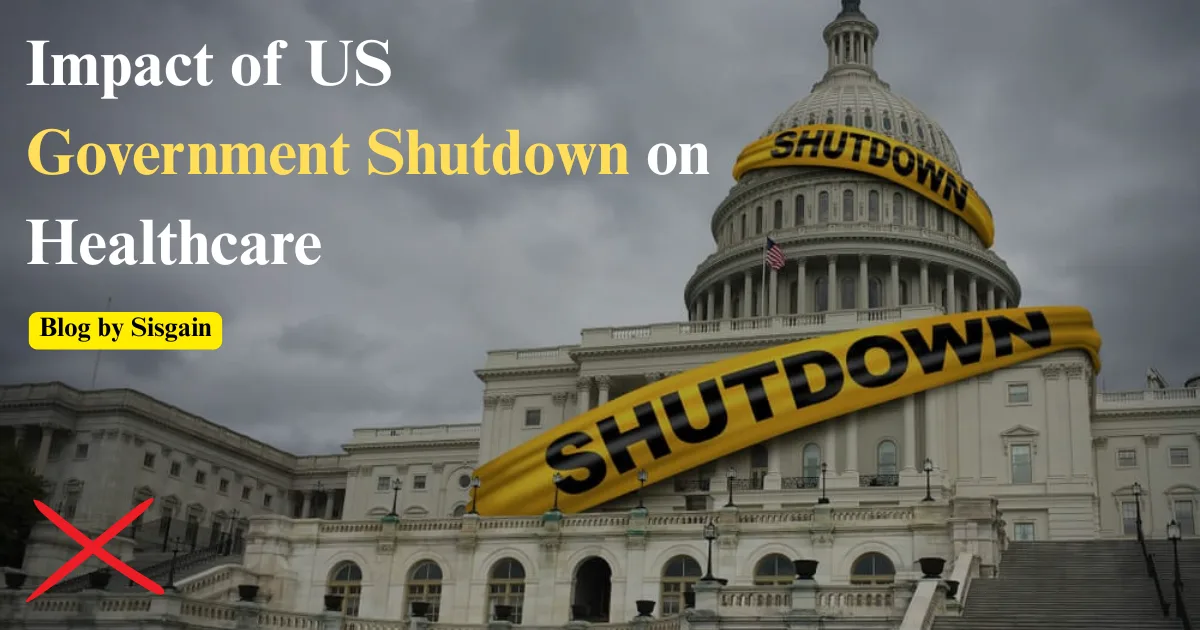Sales Team
Project quotes, partnerships, implementation

The US government shutdown is more than a political standoff — it’s a real-world disruption that affects millions of lives. Every time the federal government shuts down due to a budget impasse, essential services slow down, employees are furloughed, and critical sectors like healthcare feel the impact the most.
Hospitals face delayed reimbursements. Community health centers struggle to stay open. Medical research halts. Even public health programs pause. But amid these challenges, something positive is emerging — the rise of digital healthcare solutions.
In this blog, we’ll explore how a government shutdown affects healthcare in the United States and how digital transformation is helping keep care accessible, efficient, and resilient during uncertain times.
When Congress fails to pass a budget or temporary funding bill, the U.S. government partially shuts down. This means many departments and programs stop operating until new funding is approved.
In healthcare, the impact depends on the type of funding:
Mandatory Programs: Programs like Medicare and Medicaid usually continue because they are funded by law.
Discretionary Programs: These require annual approval, such as public health projects, community clinic funding, and research grants — and these are hit the hardest.
So while Medicare payments may continue, many health programs slow down or stop altogether, creating widespread uncertainty for both providers and patients.

Major Effects of a Government Shutdown on Healthcare
1. Payment Delays for Hospitals and Providers
Hospitals, clinics, and medical practices rely heavily on timely reimbursements from federal programs. During a shutdown, payment processing can be delayed, creating cash flow issues for healthcare organizations. Smaller facilities, especially rural hospitals, are at greater risk because they operate on thin financial margins.
2. Community Health Centers Struggle to Operate
Community health centers, which serve millions of low-income Americans, depend on federal grants. When funding halts, many centers must reduce staff, cut services, or close temporarily, leaving vulnerable communities without essential care.
3. Disruption of Telehealth Coverage
Many telehealth services operate under temporary waivers that require regular government renewal. During a shutdown, if these waivers lapse, telemedicine coverage may revert to old restrictions — such as only covering rural patients — limiting access for millions.
4. Suspension of “Hospital at Home” Programs
The “Hospital at Home” model lets patients receive hospital-level treatment at home. But these programs depend on ongoing authorization. When funding or renewals pause, hospitals must shift patients back to inpatient care, straining limited resources.
5. Halted Research and Delayed Approvals
Agencies like the FDA and NIH pause many operations during a shutdown. This leads to delays in drug approvals, medical device reviews, and clinical research. Such delays slow innovation and impact patient care nationwide.
6. Increased Insurance Premiums and Coverage Gaps
A shutdown can delay or block renewal of federal insurance subsidies under the Affordable Care Act (ACA). This means many Americans may face higher insurance costs or lose coverage altogether, especially those depending on premium tax credits.
7. Pressure on Emergency Rooms
As community clinics scale back, patients often turn to emergency rooms for help. This increases wait times, overloads hospital staff, and drives up healthcare costs — a situation that can quickly become unsustainable.
8. Slower Public Health and Preventive Services
Federal health agencies handle vaccination programs, disease tracking, and public education. During shutdowns, these services slow down, putting communities at risk of outbreaks and delayed responses.
9. Administrative Backlogs
Even programs that remain open, like Medicare, face administrative slowdowns. Claims processing, approvals, and enrollments can take much longer with fewer staff available to handle the workload.
In times of uncertainty, technology becomes a powerful ally. The Impact of U.S. Government Shutdown on Healthcare and the Rise of Digital Solutions shows how digital tools and innovations help the healthcare system stay strong, connected, and accessible — even when traditional systems face roadblocks.
Digital healthcare solutions not only ensure continuity but also lay the foundation for a more resilient, data-driven future. Today, modern healthcare providers and medical app development companies are working together to make sure care reaches every patient, no matter the situation.
1. Telehealth and Virtual Consultations
The Impact of U.S. Government Shutdown on Healthcare and the Rise of Digital Solutions can be seen clearly through the rise of telehealth. When physical clinics close or reduce hours, patients can still connect with doctors online through secure video calls or health apps. Telehealth provides safe, convenient access to care, especially for patients with chronic diseases or mobility challenges.
It also saves time and money while keeping hospital visits to a minimum. This innovation is supported by Healthcare software development services that create reliable platforms for smooth virtual consultations and patient engagement.
2. Remote Patient Monitoring (RPM)
The Impact of U.S. Government Shutdown on Healthcare and the Rise of Digital Solutions highlights how remote patient monitoring devices play a crucial role in keeping care consistent during disruptions. These smart devices and wearable sensors let doctors track a patient’s vitals — such as blood pressure, oxygen levels, and glucose readings — in real time.
This technology reduces hospital admissions, prevents emergencies, and helps manage chronic illnesses efficiently. It also allows healthcare providers to make faster decisions and respond quickly to any warning signs.
3. Mobile Health Applications
Another example of the Impact of U.S. Government Shutdown on Healthcare and the Rise of Digital Solutions is the growing popularity of mobile health applications. These apps help patients track medications, manage mental health, monitor fitness, and even attend virtual therapy sessions.
Even when in-person services are limited, mobile apps ensure 24/7 access to healthcare right from a smartphone. With the support of Patient Management Software services, these apps help healthcare providers organize patient records, automate follow-ups, and deliver personalized care experiences that build stronger doctor–patient relationships.
4. Artificial Intelligence and Predictive Analytics
The Impact of U.S. Government Shutdown on Healthcare and the Rise of Digital Solutions also extends to the growing use of artificial intelligence and data analytics. AI can analyze large sets of medical data to predict health risks, identify patterns, and support clinical decision-making.
For instance, AI tools can help healthcare teams identify high-risk patients and prioritize them for timely care. Patient Monitoring Companies are increasingly using these technologies to improve accuracy and efficiency, ensuring patient safety even when resources are limited.
5. Electronic Health Records (EHRs)
During shutdowns, digital record systems truly prove their worth. The Impact of the U.S. Government Shutdown on Healthcare and the Rise of Digital Solutions demonstrates how electronic health records (EHRs) make information sharing easier among hospitals, clinics, and labs.
When systems are connected, doctors can access patient data instantly, helping them provide faster and more accurate treatment. By using Telemedicine application development services to build integrated EHR systems, healthcare organizations can reduce duplication, minimize data loss, and deliver a smoother patient experience.
6. Chatbots and Virtual Health Assistants
A practical example of the Impact of the U.S. Government Shutdown on Healthcare and the Rise of Digital Solutions is the growing use of AI-powered chatbots and virtual health assistants. These tools help patients schedule appointments, get quick answers, or learn about treatment options without waiting on hold.
Chatbots also reduce the workload of healthcare staff, allowing them to focus on critical cases. With the support of innovative medical app development companies, these digital assistants are becoming smarter, more responsive, and capable of handling complex patient queries effectively.
7. Blockchain and Health Data Security
Finally, the Impact of U.S. Government Shutdown on Healthcare and the Rise of Digital Solutions is evident in the adoption of blockchain technology. Blockchain ensures that all patient information is stored securely and accessed only by authorized personnel.
This enhances trust and data transparency, especially when normal government oversight is delayed. Many Patient Monitoring Companies and healthcare developers are now exploring blockchain to strengthen digital security and prevent data breaches.
The rapid digitalization of healthcare brings several benefits, especially during shutdowns or emergencies:

Uninterrupted Care: Patients can still receive treatment, even when physical facilities are closed.
Lower Costs: Virtual care and automation reduce administrative and operational expenses.
Faster Communication: Digital platforms allow instant data sharing and updates.
Patient Empowerment: People take a proactive role in managing their health.
Scalability: Once implemented, digital platforms can support millions of patients simultaneously.
While digital transformation is promising, it’s not without challenges:
Regulatory Restrictions: Many digital health programs depend on temporary government waivers that need renewal.
Digital Divide: Not everyone has access to reliable internet or devices.
Cybersecurity Risks: With more online activity, data privacy must be protected.
Integration Issues: Systems need to work seamlessly across hospitals and clinics.
Training Requirements: Healthcare workers must be comfortable using new technologies.
Limited Physical Interaction: Some medical assessments still require face-to-face visits.
To prepare for future shutdowns and crises, the U.S. needs a hybrid healthcare model that combines digital tools with traditional care. Here’s how that can happen:
1. Make Telehealth Policies Permanent
Extend pandemic-era telehealth flexibilities and ensure consistent reimbursement for virtual care services.
2. Strengthen Public–Private Partnerships
Encourage collaboration between the government, tech companies, and healthcare providers to develop shared digital infrastructure.
3. Bridge the Digital Divide
Provide affordable internet, digital devices, and training for underserved populations.
4. Combine In-Person and Virtual Care
Adopt hybrid care models that balance telehealth with essential physical consultations.
5. Prioritize Cybersecurity
Invest in strong data protection measures to maintain patient trust and compliance.
6. Train Healthcare Professionals
Offer digital training and technical support to healthcare workers to ensure smooth adoption of new systems.
7. Protect Critical Health Operations
Set up “shutdown-proof” systems for essential functions like payment processing, electronic health records, and virtual care networks.
When challenges like a U.S. government shutdown disrupt healthcare services, hospitals and clinics need reliable technology partners to keep operations running smoothly. That’s where SISGAIN steps in. As a custom healthcare software development company, SISGAIN builds secure and flexible digital tools that help providers continue offering quality care — even when traditional systems face funding or staffing challenges.
In addition to developing tailored software, SISGAIN also provides remote patient monitoring services that allow doctors to track patients’ vital signs in real time. This ensures consistent care for patients at home while reducing hospital crowding during uncertain times.
Furthermore, as a leading telemedicine software development company, SISGAIN empowers healthcare organizations to deliver virtual consultations, manage appointments online, and maintain doctor-patient communication without interruption. With user-friendly platforms and HIPAA-compliant solutions, SISGAIN helps healthcare systems stay resilient, connected, and ready for the future of digital care.
The Impact of U.S. Government Shutdown on Healthcare and the Rise of Digital Solutions shows us that while political gridlocks can disrupt services, innovation continues to thrive.
Digital healthcare — through telehealth, remote monitoring, AI, and secure data systems — ensures that patients remain connected to care, even when traditional systems are paused.
Technology can’t replace every part of healthcare, but it can bridge gaps, enhance efficiency, and improve accessibility. The goal for the future is clear: build a resilient, hybrid healthcare system that can withstand crises while delivering better outcomes for all Americans.
In short, even when the government shuts down — healthcare doesn’t have to.
Project quotes, partnerships, implementation
Open roles, referrals, campus hiring